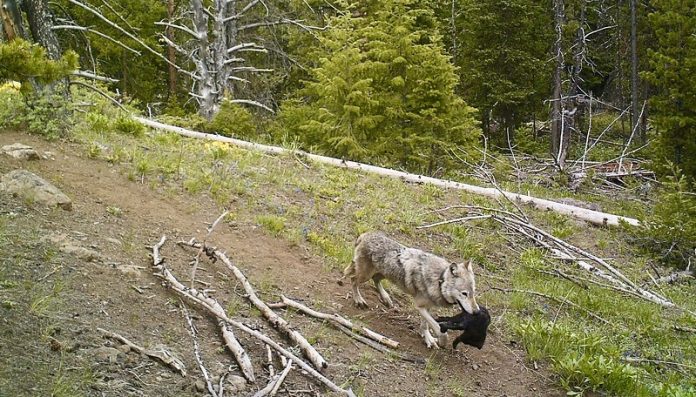
Gray wolf pups are born helpless—blind, deaf, and without the strong sense of smell that helps adult wolves survive.
Normally, these pups stay safe inside their den for at least the first three weeks of life.
That’s why researchers from UC Berkeley were surprised to see something unusual: gray wolves near Yellowstone National Park traveling over 20 kilometers through rugged mountains while carrying very young pups.
One of the researchers, Avery Shawler, described a camera trap photo of a mother wolf carrying her pup by the bottom.
“You can picture a squirming child and the mom just being like, ‘All right, we’re doing this,’” she said.
Shawler and her team believe the wolves made these risky moves to follow migrating elk, their main source of food. During spring, elk move to higher elevations, and some wolf packs appear to be adapting by shifting their own range to stay close to them.
This behavior is the first recorded case of gray wolves outside the Arctic migrating with young pups to track prey.
For a long time, scientists believed that wolves couldn’t follow elk during spring because they were tied to dens and couldn’t move with their vulnerable pups. But this study challenges that idea.
The lead researcher, Professor Arthur Middleton of UC Berkeley, said it’s important to understand how predators like wolves adapt to changes in prey movement. This knowledge can help guide conservation strategies, especially in areas where wolves, humans, and livestock share the land.
“Most wolves in the U.S. now live outside of protected parks,” said Shawler, who completed her Ph.D. at UC Berkeley in 2024. “That means they’re more likely to come into contact with people and farm animals.
Learning about how they move and adapt helps us understand potential conflicts and how to manage them.”
Gray wolves were reintroduced to Yellowstone in 1995. Since then, their population in the Greater Yellowstone Ecosystem has grown to about 500. The area is also home to tens of thousands of elk, many of which migrate during the spring.
Climate change and changes in land use are affecting both wolves and elk, forcing them to adjust their behaviors.
Middleton’s earlier research showed that elk are arriving at their winter ranges later each year—up to 50 days later in 2015 than in 2001. To learn how this affects wolves, the team tracked 19 wolves and 99 elk using GPS collars between 2019 and 2021.
They found that wolf packs reacted differently depending on how far the elk moved. Some elk herds stayed close, and those wolf packs didn’t need to move much.
But when elk traveled long distances, the wolves either “commuted”—making short trips outside their usual territory—or fully “migrated,” moving their pack to a new seasonal home. Some even carried pups up to 20 kilometers to new gathering spots known as “rendezvous sites.”
Such moves are dangerous. Wolf pups can be attacked by rival packs, especially in a crowded area like Yellowstone. “It’s pretty wild that they’re willing to take that risk,” Shawler said.
These discoveries may help scientists and land managers in other places, such as California, where wolves began returning in 2011 and now number around ten packs. Middleton is co-leading the new California Wolf Project to study how wolves are adjusting in this new environment.
“It’s still early, but we think the number and movement of deer and elk in California are affecting wolf behavior and livestock attacks,” Middleton said. “What we’re learning in Yellowstone is helping guide our approach here.”



